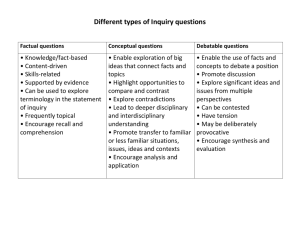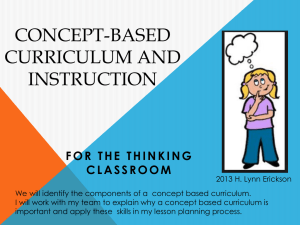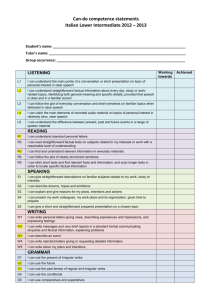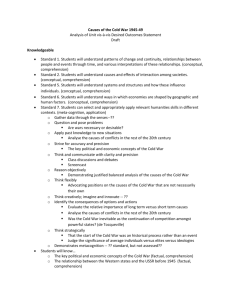Practice Test
advertisement
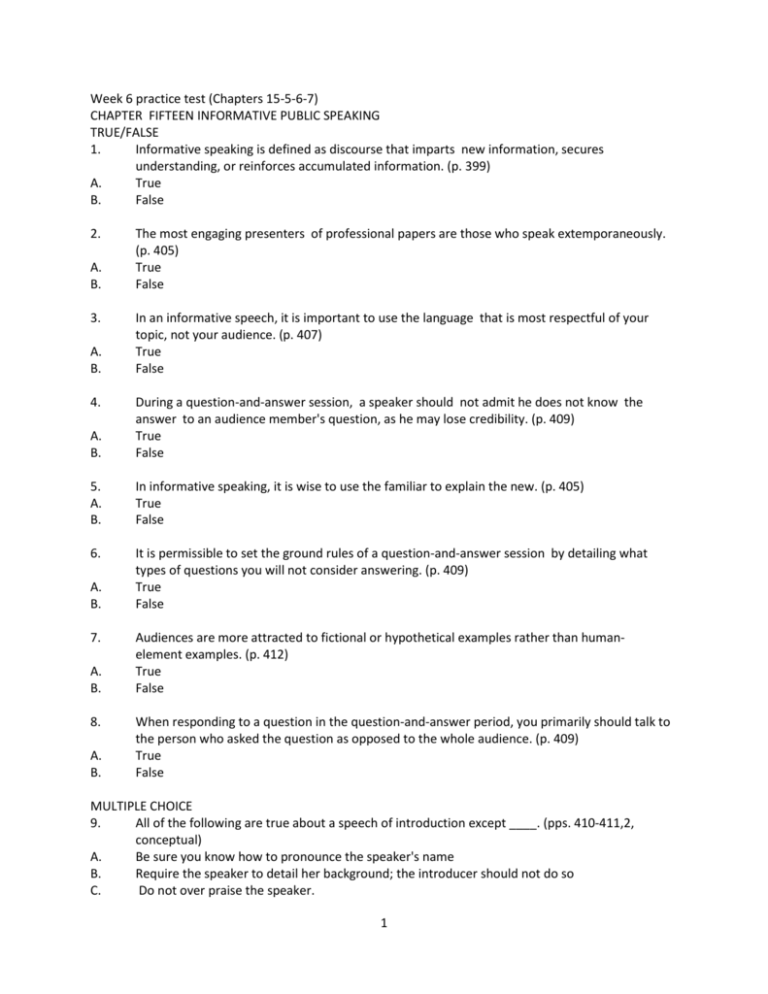
Week 6 practice test (Chapters 15-5-6-7) CHAPTER FIFTEEN INFORMATIVE PUBLIC SPEAKING TRUE/FALSE 1. Informative speaking is defined as discourse that imparts new information, secures understanding, or reinforces accumulated information. (p. 399) A. True B. False 2. A. B. 3. A. B. 4. The most engaging presenters of professional papers are those who speak extemporaneously. (p. 405) True False In an informative speech, it is important to use the language that is most respectful of your topic, not your audience. (p. 407) True False A. B. During a question-and-answer session, a speaker should not admit he does not know the answer to an audience member's question, as he may lose credibility. (p. 409) True False 5. A. B. In informative speaking, it is wise to use the familiar to explain the new. (p. 405) True False 6. It is permissible to set the ground rules of a question-and-answer session by detailing what types of questions you will not consider answering. (p. 409) True False A. B. 7. A. B. 8. A. B. Audiences are more attracted to fictional or hypothetical examples rather than humanelement examples. (p. 412) True False When responding to a question in the question-and-answer period, you primarily should talk to the person who asked the question as opposed to the whole audience. (p. 409) True False MULTIPLE CHOICE 9. All of the following are true about a speech of introduction except ____. (pps. 410-411,2, conceptual) A. Be sure you know how to pronounce the speaker's name B. Require the speaker to detail her background; the introducer should not do so C. Do not over praise the speaker. 1 D. Set the proper tone for the speech 10. "To understand the Supreme Court's decision on the University of Michigan's race-based admissions policy, it is first important to detail what led up to the decision." This statement is a signpost for a speech about a(n) _________ . (p. 402, 2, applied) Concept Process Time Event A. B. C. D. 11. A. B. C. D. 12. A. B. C. D. 13. A. B. C. D. 14. A. B. C. D. 15. According to the text, which is the most difficult part of the question-and-answer period? (p. 409, 2, factual) Getting the first question asked. The unrehearsed answers. Being knowledgeable about the subject. Building rapport with the audience. At the freshmen orientation seminar, Dean Jackson welcomes the students and then highlights the three programs on campus of which she is most proud. Therefore, Dean Jackson gave an informative speech about a(n) _________ that was arranged by __________ order. (pps. 402-403, 2, applied) Concept; topic Event; spatial Process; compare-contrast Informative briefing; time All of the following are true regarding the learning theory that relates to developing the informative speech EXCEPT _____________ . (p. 412, 3, conceptual) Learning-theory specialists stress that the basis for retention and understanding is the establishment of relationships (associations and connections) with physical or mental activities. We are more likely to remember things that are unique and different from our own experience. We can learn through repetition -hearing ideas over and over again. We can learn through experiencing-doing a task to see what it is. Which of these would not be considered informative? (p. 400, 2, conceptual) Joe gives a presentation on the 3 new accounting packages the company is considering. He is looking for feedback, and he does not have a favorite yet. Angelina reviews the procedures for the purchase order, as many of her sales representatives had questions about the process in the last month. Professor Duan-An provides a review for the communication theory midterm: Dat-Phan gives the school's valedictorian address that encourages the graduating seniors to make a mark in the world. Yonah decides to explain to the audience of high school history students how the North won the Civil War by identifying the three major battles that produced the turning point, in the order that they happened. Yonah's speech is a speech about a(n) _________ that is arranged in _______ order. (p. 402, 2, applied) 2 A. B. C. D. 16. Concept; time Event; spatial Concept; spatial Event; time A. B. C. D. For informative speaking, what is not something the speaker must determine? (p. 400, 2, conceptual) Appropriate language level Attention devices Setting of Speech Structure of the message 17. A. B. C. D. Informative speeches might be about all of the following EXCEPT _______.(p. 400, 1,factual) Objects Processes Events Influencing attitudes 18. A. B. C. D. All of the following are true about technical reports EXCEPT _______. (pps. 404-405, 2,factual) technical reports are always given to people within the industry Word choice must be appropriate for the audience Some basic assumptions about the audience's depth of knowledge can be assumed If your audience will not be hostile to your recommendation, you should state it up front 19. As a new professor, Ingrid was preparing her first lecture for her sophomore American history class. She wanted to begin with humor, as she believed it would set a good tone between her and her students. All of the following would be good ideas EXCEPT ______________. (p. 408, 2, conceptual) Using a funny quote by President Taft Showing a political cartoon from the New York Times Starting with, "you're going to really think this is funny..." Using an analogy between her first day in a college history class A. B. C. D. 20. A. B. C. D. Regina is giving a speech on AM radio signals, and she explains that AM radio signals are like a bow and arrow. The arrow, like the wave, goes as far as the bow projects it or until something gets in its way and stops it. Regina used the technique of _______ to help her listeners better understand. (p. 412,2,factual) Using the familiar to explain the new Personalizing the message Ordering her ideas clearly Providing technical information to explain the new 3 SHORT ANSWER QUESTIONS 21. One of your worst fears has come true. You have just finished delivering your informative speech, and the audience has no questions. Explain two different approaches that you might take in an effort to elicit questions. 22. Identify two strategies you will use to ensure that you have questions during your question and answer session. ESSAY QUESTIONS (Answer 1) 23. Defend or Reject: All communication contains elements of persuasion. There is no such thing as strictly informative communication. 24. As a speaker, you may think your audience has a need for particular information, but you know the audience does not feel the need. Explain and justify how you would construct your speech in an effort to gain and keep your audience's attention. CHAPTER FIVE INTRAPERSONAL COMMUNICATION TRUE/FALSE 25. Self love differs from self-confidence because it emphasizes accepting yourself as worthy versus accepting yourself as competent. (p. 122) A. True B. False 26. A. B. 27. A. B. 28. Under the age of 5, girls develop speech abilities more quickly than boys do. However, after the age of 5, there is no difference. (p. 117) True False Research shows that more women than men have anxiety disorders; however, more men than women seek professional help with it. (p. 133) True False A. B. The imbalance between your values, attitudes, and beliefs is known as cognitive dissonance. (p. 123) True False 29. A. B. Anxiety is the perceived or real threat of danger. (p. 131) True False 30. Your public self is the part of you that feels comfortable expressing all of your thoughts and beliefs to others. (p. 123) True False A. B. 4 31. A. B. An informal definition of "Intrapersonal Communication" is talking to yourself. (p. 115) True False 32. To qualify as Intrapersonal Communication, one must consciously and intentionally communicate with oneself. (p. 115) True False A. B. 33. A. B. 34. A. B. It is hypothesized that one of the effects of mediated communication, like text messaging and email, is that individuals are becoming more shy. (p. 133) True False A child will develop proficient language skills even ifhe/she is denied social interaction with others. (p. 117) True False MULTIPLE CHOICE 35. Which of the following groups is NOT focused on a "doing-oriented approach to life"? (p. 139, 1, conceptual) A. Asian Americans B. Native Americans C. Latin Americans D. Middle- Class African Americans 36. A. B. C. D. 37. A. B. C. D. Leo doesn't know the answer to an exam question and he notices that the person sitting next to him is answering the very question that has stumped him. He wants to look onto her paper to see the answer but his conscience is telling him, "Don't do that! It's wrong. It's cheating. I may get a better grade, but it wouldn't be worth it!" The cognitive dissonance that Leo is feeling is caused by an imbalance between his actions and his ____________. (p. 123, 2, conceptual) Values Beliefs Attitudes Any of the above Lupe is riding the train in Washington, DC. When she enters, she sits in the aisle seat, leaving the window seat open. When others board the train, she does not make eye contact in the hopes that they would not sit next to her. Lupe is exhibiting behavior. (p. 130, 2, applied) Pleasure seeking Territoriality Security Survival 5 38. A. B. C. D. Chris is going to an interview for a job that he really wants. When the interviewer asks him a question, he realizes that he is sweating and cannot think clearly. Chris does this every time that someone asks him a question that he is expected to answer. Chris is most likely experiencing ________________. (p. 132, 2, applied) Interview anxiety A lack of concentration Communication apprehension Internal dissonance 39. A. B. C. D. The ingredients in anxiety are a combination of _______________. (p. 131, 2, conceptual) Biological reaction, Personality type, Normal stresses of life Emotional state, Personality type, Normal stresses of life Biological reaction, Characteristics, Normal stresses of 1ife Emotional state, Personality type, Abnormal stresses of life 40. Johanna is eight years old and her father has given her a puzzle to complete. Her father can hear her talking to herself about how she should start solving the puzzle. This is because ___________. (p. 116, 2, applied) Children are more comfortable speaking out loud She is too young to conceptualize internally She is thinking in abstraction None of the above A. B. C. D. 41. A. B. C. D. 42. A. B. C. D. __________________ is the comprehending, organizing, and storing of ideas. It is how we process information in relationship to values, attitudes, and beliefs. (p. 122, 1, factual) Communication Self-talk Cognitive processing None of the above Our perceptions of positive and negative worth, such as the Protestant work ethic or the belief that family is more important than profession, are our ________. (p. 122, 1, factual) Attitudes Beliefs Values Cognitions 43. Our predispositions, such as "I'd rather hunters ate what they caught as opposed to hunting for fun" are our _________. (p. 122, 1, factual) A. Attitudes B. Beliefs C. Values D. Cognitions 44. A. B. The part of ourselves that we let others see is our ______________. (p. 123, 1, factual) Real self. Ideal self. 6 C. D. Public self. Cognitions 45. A. Which of the following is false about self-esteem? (p. 117, 2, conceptual) Self-esteem is situational. Who you are with one person, may not be the same as who you are with someone else. Both psychologists and educators have been interested in the study of self-esteem. Your level of self-esteem cannot be changed through your lifetime. Your self-esteem is constantly on display when you interact with others. B. C. D. 46. A. B. C. D. You are baby-sitting your niece and nephew, and you take them to the public swimming pool. Your nephew jumps into the deep water, but he can't swim. Without remembering that you can't swim either, you jump in after him. Which Needs Drive theory were you displaying? (p. 129, 2, applied) Territoriality Survival of the Species Pleasure-Seeking Security 47. At what age does one usually move to the rhetorical stage where she/he can think in abstractions and have a large enough vocabulary to use communicative strategies? (p.117, 2, factual) A. 7-8 B. 9-10 C. 12-13 D. 14-16 SHORT ANSWER QUESTIONS 48. Explain how self-talk affects the communication of an interpersonal communicator. Provide 2 ways that you could currently use positive self-talk to your advantage. 49. Define and give a personal example each of Value, Attitude, and Belief. ESSAY QUESTIONS 50. Defend or reject: A person must master the conceptual stage prior to entering the rhetorical stage. 51. The text provides 5 ways to reduce or eliminate communication apprehension including Skill Training, Systematic Desensitization, Cognitive Modification, Willingness to Communicate, and Drug Therapy. Select two of them and explain why they would be best for you or a peer in this class. CHAPTER SIX THE CONCEPTS OF INTERPERSONAL COMMUNICATION TRUE/FALSE 52. There is no difference between men's and women's brains. Perception differences are socially constructed. (pps. 154-155) A. True B. False 7 53. A. B. 54. A. B. 55. A. B. 56. A person who acts with androgyny is communicating from solely one standpoint, either male or female. (p. 159) True False The way in which other individuals interpret your words, actions, and expressions is best described as the Self-Perceived I. (p. 147) True False Sex refers to one's biological or physical self [male/female] while gender refers to one's psychological, social, and interactive characteristics [man/woman]. Thus sex is socially constructed and gender is determined by sexual organs. (p. 155) True False A. B. When communicating, it is believed that masculine communicators tend to be competitive, to gain attention, and to maintain their positions in the social hierarchy, while feminine communicators communicate to use language to connect and create intimacy. (p. 157) True False 57. A. B. Men use more words to get their point across than women do. (p. 157) True False 58. According to recent research, employers value positive interpersonal skills more than grade point average when hiring recent college graduates. (p. 143) True False A. B. 59. A. B. 60. A tag question is a question added onto the end of statements and is more commonly used by men. (p. 158) True False A. B. It has been estimated that 30% of our actions are emotional, meaning 70% is intellectual. (p. 151) True False 61. A. B. A dysfunctional system can not operate. (p. 169) True False MULTIPLE CHOICE 62. The difference between the Differentiating stage and the Terminating stage in Knapp's Relationship Termination Model is __________. (pps. 171-172, 2, conceptual) 8 A. B. C. D. 63. A. B. C. D. 64. A. B. C. D. 65. A. B. C. D. 66. A. B. C. D. 67. A. B. C. D. Terminating comes before differentiating You can experience Terminating without experiencing differentiating Differentiating is the need for one to assert independence while Terminating ends the relationship. Terminating never hurts while the Differentiating does. Antonio is ridiculed by others because his clothes aren't from a designer label. However, he chooses to accept himself as a worthy person despite how others feel. Antonio has achieved _________. (p. 150, 2, applied) Self-love Self-fulfillment Self-confidence None of the above. We apply the skills of persuasion in our interpersonal communication because in our relationships with others we need things. The things we are in search of include having others do things for us, agree with us, or simply engage with us. If we are successful in our efforts of persuasion, then we have achieved __________ . (p. 150, 1, factual) Liking Promise Esteem Compliance Nyla lives next to you in the dorm, and she has asked you for a ride to the airport at Thanksgiving break. You know that you'll need a ride to the airport for spring break, so you figure if you take her, then she'll take you. Using the economic model of relationships, Nyla's request to you is the ___________, and her taking you to the airport is your ________. (p. 167, 3, conceptual) Relational cost/relational overture Relational reward/relational cost Relational overture/relational reward Relational cost/relational reward One foundation of interpersonal communication is that two communicators send and receive messages. If they are sending and receiving messages simultaneously, then the best communication models from chapter 1 that describe the process are_. (p. 143, 3, conceptual) Linear and Interactional Interactional and Transactional Transactional and Linear Linear, Transactional, and Interactional In the process of human development, two brains were formed. According to the theory on how the brain works, which of these is true? (p. 151, 2, factual) It has been estimated that 90% of our actions are emotional, and only 10% are intellectual. The first brain to develop was the logical brain (the left lobe). The logical brain triggers first. Most people make decisions intellectually. 9 68. A. B. C. D. 69. A. B. C. D. 70. A. B. C. D. 71. A. B. C. D. 72. A. B. C. D. 73. A. B. C. D. Anita works for Tom in company A, and Sandy works alone in company B. The companies will merge, and Sandy will take the management position, meaning Anita and Tom will report to her. When moving to the new system, it is possible that Anita and Tom will have difficulty adjusting because _______________. (p. 152, 2, applied) Anita and Tom do not like Sandy Sandy is a woman, and Anita does not like working for women Tom and Anita will have a different power relationship Competitors never get along. Josephine believes that she is not attractive. Consequently, she does not pay much attention to grooming, and she wears oversized clothes. This representation is best known as Josephine's __________. (p. 147, 1, applied) Self-perceived I Other-perceived me Other-perceived you None of the above Jeff does not have great self-esteem; however, his co-workers find him to be affable, conscientious, and goal-oriented. The collective judgments of Jeffs co-workers are known as Jeff’s ___________. (p. 147, 1, applied) Self-perceived I Other-perceived me Other-perceived you None of the above. The basic concepts of interpersonal communication include all of the following EXCEPT _______________. (pps. 143-145, 2, factual) We teach others how to treat us Meaning is in people, not in words We cannot not communicate People only sometimes react to our actions _______________ is the ability to control what happens; to cause things you want to happen and to block things you don't want to happen. (pps. 151-152, 1, factual) Power Control Responsibility None of the above Linda and Neal have been married for 12 years. Whenever Linda asks Neal a question, and he does not respond, Linda gets mad. This best describes which of the following basic concepts of interpersonal communication? (pps. 143-145, 3, applied) Communication takes place within a system. We teach others how to treat us. Meaning is in people, not words. We cannot not communicate. 10 74. A. B. C. D. Which is not a stage of relational conflict? (p. 170, 2, conceptual) Development of tension False ignoring Blaming Resentment 75. Emily and Jonathan began dating two months ago. Jonathan began to get very controlling by telling Emily which of her friends were good, who she could see and when, and what a "good" relationship looked like. They were experiencing __________ . (p. 169, 2, applied) Relational control Relational power dogmas Relational fusion Relational acceptance A. B. C. D. 76. A. B. C. D. A group of students is attempting to form a new political action group on campus. To succeed, they must prove that they have enough support from the campus community and gain the campus President's approval. The group consists of Jake, who worked in a Washington D.C. political lobby firm for 3 summers; Jada, who has been elected the group leader; and Elmo, who started the group and is the memnber that all other members know and like. The type of power that best characterizes Jake is ___________. (pps. 153-154, 2, conceptual) Expert Legitimate Coercive Referent SHORT ANSWER QUESTIONS 77. Explain the Economic Model of Relationships. Then provide a personal example from your life that illustrates the theory. 78. Do you believe that positive, lasting relationships can be developed on the Internet? Why or why not? If you support the notion, are there any modifications that need to take place? ESSAY QUESTIONS 79. Below are five basic interpersonal concepts. Select three. Define each, and then provide a personal example from your life that illustrates the concept. A. Communication takes place within a system. B. People react to our actions. C. We cannot not communicate. D. Meaning is in people, not in words. E. We teach others how to treat us. 80. First, define "power" within the context of one of your interpersonal relationships. Then indicate how power affects the communication within that relationship. Finally, provide one suggestion on how the power relationship might be shifted through communication, and the effect that you would expect it to have. 11 CHAPTER SEVEN INTERPERSONAL SKILLS TRUE/FALSE 81. Many people are afraid to ask questions because they do not know how to do so or they are afraid of looking stupid. (p. 190) A. True B. False 82. A. B. 83. A. B. 84. A. B. 85. The difference between a simple assertion and an empathic assertion is that the latter recognizes and verbalizes the other's position, but the former does not. (p. 206) True False Being able to verbalize what makes you angry can help you better understand why you are upset, which can then help you figure out what to do about it. (p. 195) True False When face-to face apologies are not possible, then the next best method is E-mail. (p. 216) True False A. B. All of the personal conflict management styles are context-specific, meaning that they are good styles to use at certain times, and poor styles to use at other times. (pps. 212-213) True False 86. A. B. You should continue apologizing until the other person forgives you. (p. 216) True False 87. A. B. A passive-aggressive person attacks or embarrasses another in a manipulative way. (p. 205) True False 88. A. B. Research shows that US Americans apologize twice as much as the Japanese. (p. 217) True False 89. A. B. According to research, students try to avoid about 12% of their conflicts. (p. 191) True False 90 The main goal of arbitration is that both parties are satisfied with the outcome. (p. 211) A. True B. False 12 91. A. B. Facework refers to verbal and nonverbal behaviors that one uses to maintain or defend one's own or the other's self-image. (p. 213) True False MULTIPLE CHOICE 92. Which of the following is not an effective strategy when you are criticized? (pps. 213214, 2, factual) A. Seek more information. B. Paraphrase the other person's criticism to tnake certain that you understand it correctly. C. Accept the criticism, even if you do not agree with it, especially if the relationship is not important to you. D. Accept the criticism, if you agree with it. 93. A. B. C. D. 94. A. B. C. D. 95. A. B. C. D. 96. A. B. C. D. The four root causes of conflict include all of the following except which one? (pps. 192193, 2, factual) Goals to be pursued Allocation of resources Self esteem Behaviors considered inappropriate by one party Laura has an important relationship with Ellen, which she does not want to damage. Their most recent conflict was about scheduling a meeting in terms of time and location. Both listened to what was important to the other and why it was important, and both ultimately gained what each wanted. The conflict management style that best represents this scenario is _______. (pps. 202-203, 3, applied). Accommodation Compromise Avoidance Integration Whenever Diana goes to an employment interview, one of the first questions she asks is, "Can you tell me three qualities that you'd like to see in the person you hire for this position?" This type of question is one that will help her _____________. (p. 185, 3, conceptual). Learn more about the interviewer's attitude is toward a topic. Gain information about what is important Show the interviewer that she is interested in the position. Keep the conversation on track. Jun Kim and Joe Baker are conducting a business transaction together. Joe Baker lays out the specific points that he wants to discuss and dissects all the feedback to analyze it before coming to a swift conclusion. Mr. Kim, on the other hand, takes his time in reaching conclusions and tells many stories about previous business transactions he has had. What is happening here? (p. 185, 3, conceptual). Joe Baker is using the spiral method of agreement. Jun Kim is negotiating from an analytical win-win stance. Jun Kim is a holistic thinker and Joe Baker is an analytical thinker. Joe Baker is a holistic thinker and Jun Kim is an analytical thinker. 13 97. A. B. C. D. Which is the best definition of assertive communication behavior? (p. 204, 2, factual) When a person stands up for and tries to achieve personal right without damaging others. When a person takes advantages of others for personal gain. When a person puts the other in a better face position. When a person uses passive aggressive techniques that are more passive than aggressive. 98. All of the following are true about cultures and apologies EXCEPT _________. (p. 217, 3, conceptual) In Asian cultures, apologizing is considered a virtue. Western cultures are more concerned for the group, so apologies come from the group. Americans have one word for apologies while the Japanese have seven. Euro-American males are more apt to apologize to strangers than friends. A. B. C. D. 99. A. B. C. D. 100. A. B. C. D. 101. A. B. C. D. 102. A. B. C. D. Which of these is a characteristic of holistic thinking? (p. 185, 3, factual) It is more typical in North American and German cultures than in the SouthAmerican and Asian cultures. It does not dissect events or concepts. Storytelling is confusing and often avoided. Stories and parables always have a conclusion and a moral. A man on a cell phone cuts in front of you at the deli counter during your half hour lunch break. You know that it takes a while for them to make each sandwich and you can hear the man asking the person on the other end of the phone what they would like to order. What would be the most appropriate response to practice assertive skills? (pps. 206-207, 3, applied) Don't say anything and just deal with the fact that you are going to be late getting back to work. Step on his foot and then take your place back in line. Say, "I was here first, and the end of the line is back there." Say, "I was here first, but I guess you can cut in front of me." Small talk, the exchange of information with someone on a surface level, usually lasts for about ___________ before more in-depth conversation begins. (p. 184, 1, factual) 30 seconds 15 minutes 1 hour None of the above Which of the following is false regarding assertive behavior? (pps. 204-207, 3, conceptual) If you are assertive, you will always get your way. Being assertive probably will not get the negative reactions that you might receive if you were aggressive. DESC scripting is a way of dealing with interpersonal conflicts that centers on the process of describing, expressing, specifying and stating consequences. When you decide to be assertive, be aware of the consequences; do not make a threat unless you are willing to accept the responsibility and take the action. 14 103. A. B. C. D. In class, Tara, the student, said to the teacher, "I'm sorry, but I don't understand. Can you say that again, but use different words?" Tara was asking for _______. (p. 190 , 2, applied) Restatement Definition Clarification All of the above 104. A. B. C. D. DESC is a method to ________. (p. 207, 1, factual) Handle conflicts Ask for further information Confirm your understanding of a situation , Switch channels in the middle of the communication SHORT ANSWER QUESTIONS 105. Which is more important: A good conversationalist must be a good listener, or a good conversationalist must be a good speaker? Support your position with material that you have learned in class. 106. Describe 3 skills that one should have to be considered a good conversationalist. ESSAY QUESTIONS 107. The textbook identifies two ways to stand up for yourself without putting down others. They are Assertions and DESC scripting. Select one of them, explain its components, and then defend or reject how it could make you a better communicator. 108. Explain the difference between arbitration, mediation, and litigation. Explain which you would recommend in a child-custody dispute and why. 15
